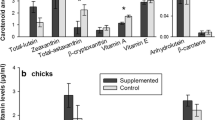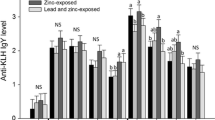Abstract
Previous ecotoxicological studies have documented relationships between residues of various organochlorines (OCs) and immune status, carotenoid colors, and wing feather growth in different bird species. In this study, the density of white blood cells (WBC), carotenoid colors, and length of the same feathers on each wing were measured in breeding great black-backed gulls (Larus marinus) on the coast of northern Norway, and related to the blood residues of five OCs, including HCB (hexachlorobenzene), β-HCH (β-hexachlorocyclohexane), p,p′-DDE (p, p′-dichlorodiphenyldichloroethylene), oxychlordane, and polychlorinated biphenyl (PCB), in addition to ΣOC. Neither, WBC density nor carotenoid colors were significantly related to blood residues of any of the OCs, suggesting that OC levels may have been too low to significantly affect these outcome parameters. However, in the colony where the OC concentrations were highest, there was a weak but significantly positive relationship between the probability of having different length of feathers on each wing and levels of PCB and ΣOC, in males. Thus varying length of the wing primaries may reflect adverse impacts of OCs in great black-backed gulls. However, in gulls with moderate levels of OCs, it is probably not a sensitive indicator of progressing ecological impacts of OCs, since such adverse ecological relationships were found in the breeding colonies where there were no relationships between differences in wing feather lengths and OCs.

Similar content being viewed by others
References
Andersen M, Lie E, Derocher AE, Belikov SE, Bernhoft A, Bolutov AN, Garner GW, Skaare JU, Wiig Ø (2001) Geographic variation of PCB congeners in polar bears (Ursus maritimus) from Svalbard east to the Chukchi Sea. Polar Biol 24:231–238
Averbeck C, (1992) Haematology and blood chemistry of healthy and clinically abnormal great black-backed Gulls (Larus marinus) and herring Gulls (Larus argentatus). Avian Pathol 21:215–223
Bendich A (1989) Carotenoids and the immune response. J. Nutrition 119:112–115
Bortolotti GR, Fernie KJ, Smits JE (2003a) Carotenoid concentration and coloration of American kestrel (Falco sparverius) disrupted by experimental exposure to PCBs. Funct Ecol 17:651–657
Bortolotti GR, Smits JE, Bird DM (2003b) Iris colour in American kestrel varies with age, sex, and exposure to PCBs. Physiol Biochem Zool 76:99–104
Bustnes JO (2006) Pinpointing potential causative agents in mixtures of persistent organic pollutants in observational field studies: a review of glaucous gull studies. J Toxicol Environ Health, Part A 69:97–108
Bustnes JO, Bakken V, Erikstad KE, Mehlum F, Skaare JU (2001a) Patterns of incubation and nest site attentiveness in relation to polychlorinated bipheny1 (PCB) contamination in glaucous gulls. J Appl Ecol 38:791–801
Bustnes JO, Skaare JU, Erikstad KE, Bakken V, Mehlum F (2001b) Whole blood concentrations of organochlorines as a dose metric for studies of the glaucous gull (Larus hyperboreus). Environ Toxicol Chem 20:1046–1052
Bustnes JO, Folstad I, Erikstad KE, Fjeld M, Miland ØO, Skaare JU (2002) Blood concentration of organochlorines and wing feather asymmetry in glaucous gull. Funct Ecol 16:617–622
Bustnes JO, Erikstad KE, Skaare JU, Bakken V, Mehlum F (2003) Ecological effects of organochlorine pollutants in the Arctic: a study of the glaucous gull. Ecol Appl 13:504–515
Bustnes JO, Hanssen SA, Folstad I, Erikstad KE, Hasselquist D, Skaare JU (2004) Immune function and organochlorine pollutants in arctic breeding glaucous gull. Arch Environ Contam Toxicol 47:530–541
Bustnes JO, Skaare JU, Berg V, Tveraa T (2005). Interseasonal variation in blood concentrations of organochlorines in great black-backed gulls (Larus marinus). Environ Toxicol Chem 24:1801–1806
Butler RG, Butler SJ (1983) Sexual differences in the behavior of adult great black-backed gulls (Larus marinus) during the pre- and post-hatch periods. Auk 100:63–75
Camplani A, Saino N, Møller AP (1999) Carotenoids, sexual signals and immune function in barn swallows from Chernobyl. Proc R Soc B 266:1111–1116
Carrascal LM, Senar JC, Mozetich I, Uribe F, Domenech J (1998) Interactions among environmental stress, body condition, nutritional status, and dominance in great tits. Auk 15:727–738
Chew BP (1993) Role of carotenoids in the immune response. J Dairy Sci 76:2804–11
Coulson JC, Thomas CS (1983) The use of head and bill length to sex live gulls Laridae, Ibis 125:549–557
Edge R, McGarvey DJ, Truscott TG (1997) The carotenoids as anti-oxidants - a review. J Photochem Photobiol 41:189–200
Eeva T, Lehikoinen E, Rönkä M (1998) Air pollution fades the plumage of great tit. Funct Ecol 12:607–612
Eeva T, Tanhuanpaa S, Råbergh C, Airaksinen S, Nikinmaa M, Lehikoinen E (2000) Biomarkers and fluctuating asymmetry as indicators of pollution-induced stress in two hole-nesting passerines. Funct Ecol 14:235–243
Furness R, Barrett RT (1985) The food requirements and ecological relationships of a seabird community in north Norway. Ornis Scand 16:305–313
García-Berthou E (2001) On the misuse of residuals in ecology: testing regression residuals vs. the analysis of covariance. J Anim Ecol 70:708–711
Grasman KA, Fox GA (2001) Associations between altered immune function and organochlorine contamination in young Caspian terns (Sterna caspid) from Lake Huron, 1997–1999. Ecotoxicology 10:101–114
Grasman KA, Fox GA, Scanlon PF, Ludwig JP (1996) Organochlorine-associated immunosuppresion in prefledging Caspian terns and herring gulls from the Great Lakes: an epidemiological study. Environ Health Perspec 104(suppl):829–841
Grasman KA, Scanlon PF, Fox GA (2000) Geographic variation in haematological variables in adult and prefledling herring gulls (Larus argentatus) and possible associations with organochlorine exposure. Arch Environ Contam Toxicol 38:244–253
Handy RD, Galloway TS, Depledge MH (2003) A proposal for the use of biomarkers for the assement of chronic pollution and regulatory toxicology. Ecotoxicology 12:331–343
Helberg M, Bustnes JO, Erikstad KE, Kristiansen KO, Skaare JU (2005) Relationships between reproductive performance and organochlorine contaminants in great black-backed gulls (Larus marinus). Environ Pollut 134:475–483
Henriksen EO, Gabrielsen GW, Skaare JU (1998) Validation of the use of blood samples to assess tissue concentrations of organochlorines in glaucous gull Larus hyperboreus. Chemosphere 37:2627–2643
Kleinbaum DG, Kupper LL, Muller KE, Nizam A (1998) Applied regresson analysis and other multivariate methods. Duxbury Press, Pacific Grove, CA
Krinsky NI (1998) The antioxidant and biological properties of the carotenoids. Ann New York Acad Sci 854:443–447
Kristiansen KO, Bustnes JO, Folstad I, Helberg M (2006) Carotenoid coloration in great black-backed gull reflects individual quality. J Avian Biol 37:58–68
Massaro M, Davis LS, Darby JT (2003) Carotenoid-derived ornaments reflect parental quality in male and female yellow-eyed penguins (Meagadyptes antipodes). Behav Ecol Sociobiol 55:169–175
Mawhinney K, Diamond T (1999) Sex determination of great black-backed gulls using morphometric characters. J Field Ornithol 70:206–210
McCarty JP, Secord AL (2000) Possible effects of PCB contamination on female plumage color and reproductive success in Hudson River tree swallows. Auk 117:987–995
Møller AP, Mousseau TA (2001) Albinism and phenotype of barn swallows (Hirundo rustled) from Chernobyl. Evolution 55:2097–2104
Møller AP, Swaddle JP (1997) Asymmetry, developmental stability, and evolution. Oxford University Press, Oxford
Møller AP, Biard C, Blount JD, Houston DC, Ninni P, Saino N, Surai PF (2000) Carotenoid-dependent signals: indicators of foraging efficiency, immunocompetence or detoxification ability? Avian Poul Biol Rev 11:137–159
Nakagawa S (2004) A farewell to Bonferroni: the problems of low statistical power and publication bias. Behav Ecol 15:1044–1045
Norris K, Evans MR (2000) Ecological immunology: life history trade-offs and immune defence in birds. Behav Ecol 11:19–26
Olson VA, Owens IFF (1998) Costly sexual signals: are carotenoids rare, risky or required? Trends Ecol Evol 13:510–514
Peakall DB (1994) The role of biomarkers in environmental assessment. (1). Introduction. Ecotoxicology 3:157–160
Pusch K, Schlabach M, Prinzinger R, Gabrielsen GW (2005) Gull eggs - food of high organic pollutant content? J Environ Monit 7:635–639
Rothman KJ, (1990) No adjustments are needed for multiple comparisons. Epidemiology 1:43–46
SAS Institute. Inc (1999) SAS OnlineDoc®, Version 8. SAS Institute, Inc., Cary, NC
Sheldon BC, Verhulst S (1996) Ecological immunology: costly parasite defences and trade offs in evolutionary ecology. Trends Ecol Evol 11:317–321
Siva-Jothy M (1995) Immunocompetence: conspicuous by its absence. Trends Ecol Evol 10:205–206
Swaddle JP, Witter MS (1994) Food, feathers and fluctuating asymmetries. Proo R Soc B 255:147–152
Thomas ALR (1993) The aerodynamic costs of asymmetry in the wings and tail of birds - asymmetric birds can’t fly round tight corners. Proc R Soc B 254:181–189
Van Poppel G, Spanliaak S, Ockliuizen T (1993) Effect of β-carotene on immunological indexes in healthy male smokers. Am J Clin Nutrition 57:402–407
Verreault J, Skaare JU, Jenssen BM, Gabrielsen GW (2004) Effects of organcohlorine contaminants on thyroid hormone levels in Arctic breeding glaucous gulls Larus hyperboreus. Environ Health Perspec 112:532–537
Weseloh DV, Hughes KD, Ewins PJ, Best D, Kubiak T, Shieldcastle MC (2002) Herring gulls and great black-backed gulls as indicators of contaminants in bald eagles in Lake Ontario, Canada. Environ Toxicol Chem 21:1015–1025
Witter MS, Lee SJ (1995) Habitat structure, stress and plumage development. Proc R Soc B 261:303–308
Zahavi A (1975) The handicap principle: A missing piece of Dawins’s puzzle. Oxford University Press, Oxford
Acknowledgments
We are grateful to John Andre Henden, Øystein Varpe, and Espen Dahl for valuable help during field work, and Anuschka Polder and her team at the Norwegian National Veterinary Institute for conducting the OC analyses. We also thank two anonymous reviewers for comments that greatly improved an earlier draft of the manuscript. The study was funded by the Norwegian Research Council (Project number 141443/S30).
Author information
Authors and Affiliations
Corresponding author
Rights and permissions
About this article
Cite this article
Bustnes, J.O., Kristiansen, K.O. & Helberg, M. Immune Status, Carotenoid Coloration, and Wing Feather Growth in Relation to Organochlorine Pollutants in Great Black-Backed Gulls. Arch Environ Contam Toxicol 53, 96–102 (2007). https://doi.org/10.1007/s00244-005-0269-3
Received:
Accepted:
Published:
Issue Date:
DOI: https://doi.org/10.1007/s00244-005-0269-3




